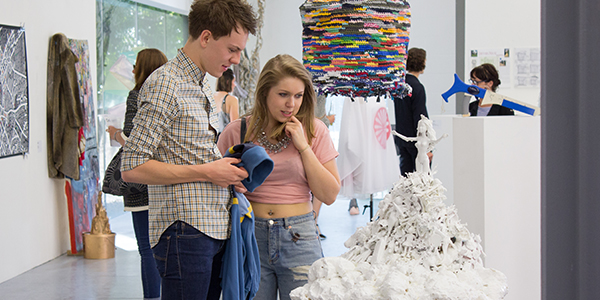Vicky Cull is the course leader for Suffolk New College’s Foundation Diploma in Art and Design and Extended Diploma in Art & Design courses. She has been responsible for planning and organising all of the college’s final art and design shows for the last 20 years and is also planning the University of Suffolk‘s BA and MA Fine Art & Arts Practice shows this year. She shares her tips for organising a successful end of year exhibition…
My advice to anyone embarking on a student exhibition is to plan, plan, plan some more… and be prepared to compromise!
I always start by asking a series of questions that are specific to the course, team and exhibition spaces. These may typically be:
- What sort of show do we want (e.g. minimal, salon hang, interactive, multi-platform)?
- Why are we having a show (what does it need to achieve, who is it for)?
- Where is it going to be (e.g. in a gallery space, studios/workshops, corridors, off-site) and how can these spaces be adapted?
- Do students have an input into the planning of the space?
- Who decides what goes where – the course leader, subject leader or the students?
With answers to these questions established, here are my 10 top tips for organising your end of year show…
Let your students know what type of show you are organising
This may sound like an obvious tip, but in the pursuit of ‘trying to get everything done’, it’s easy to overlook the simple process of communication with your students. Talk to them in good time. Give them a flavour of what’s to come and get them excited!
Have a clear understanding of all of your students’ project themes
Talk to each student to gain an understanding of their requirements for the exhibition and to ensure that their individual needs are taken into consideration. Some courses have very large cohorts so it is useful to collate this information in advance for the whole team to work from.
Create a visual consistency
There should be a visual consistency running through your show collateral and promotional materials, including but not limited to: labels, statements, invites, posters, social media assets, digital content and show signage. This may even include agreed hanging processes and other methods for displaying work.
Clearly define your team’s roles
Clearly defined roles will help to minimise creative and conceptual disagreements. Provide everyone involved with a clearly defined role at the beginning of the planning process (including staff, technicians and students) and create a short written guide to ensure that they all have a shared approach to the exhibition.
Understand your deadlines – and stick to them!
Develop a clear week-by-week plan, including key responsibilities and deadlines, at the beginning of the final major project. Share it with your students and all staff involved in the process (including support staff, caretakers, security, health and safety and marketing).
Work out your timings
Ensure you allocate appropriate amounts of time for building the show, hanging work, marking work and the external moderation visit.
Find a cohesion
As a curator, you need to find a way to pull all of the projects together in a cohesive way. Students generally want the exhibition to represent their own individuality, so compromise is necessary!
Collect technical requests
Some students will have specific technical requirements; it’s best to ascertain their needs early on to decide where in the exhibition to place them. Technical requirements might include:
- Plug sockets
- Corners
- Shelves
- Lighting
- Dark spaces
- Sound proof spaces
- Number of plinths
- Shelves
- Cabinets
- Projectors
Publish Your dos and don’ts
Publish a list of dos and don’ts for students in advance of the show. This might include aesthetic considerations, health and safety guidance and hanging instructions. It can also be helpful to share a code of conduct outlining the behaviour you expect from your students.
Future proof your show’s design process
Hold a wash-up meeting at the end of the exhibition with all of the staff involved. This will help you to review what went well and what could be improved ahead of next year’s show.

